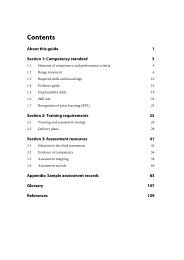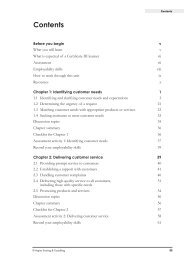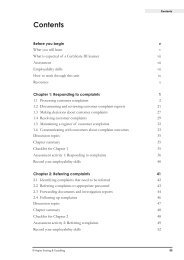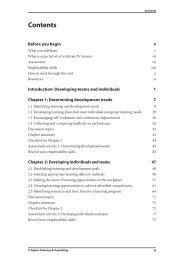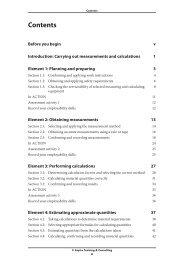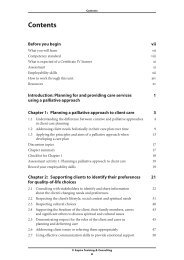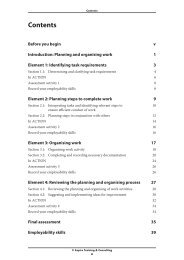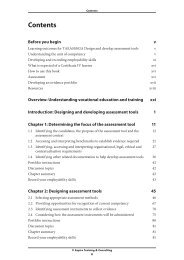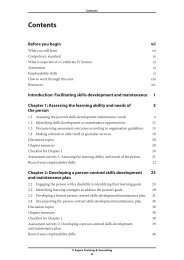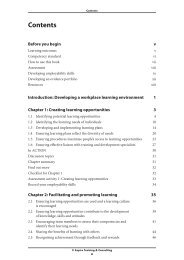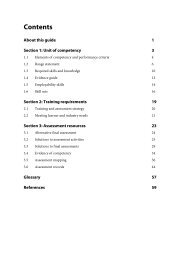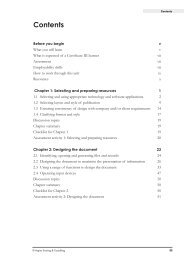MSACMT430A Improve cost factors in work practices
MSACMT430A Improve cost factors in work practices
MSACMT430A Improve cost factors in work practices
Create successful ePaper yourself
Turn your PDF publications into a flip-book with our unique Google optimized e-Paper software.
Contents<br />
Contents<br />
Gett<strong>in</strong>g started<br />
Purpose<br />
Scope<br />
Learn<strong>in</strong>g outcomes<br />
Develop<strong>in</strong>g employability skills<br />
Assessment<br />
Resources<br />
iii<br />
iii<br />
iii<br />
iv<br />
v<br />
vii<br />
viii<br />
<strong>Improve</strong> <strong>cost</strong> <strong>factors</strong> <strong>in</strong> <strong>work</strong> <strong>practices</strong> – An overview<br />
ix<br />
Chapter 1: Analyse <strong>cost</strong> components of a team’s function 1<br />
1.1 Identify <strong>cost</strong> components <strong>in</strong> the product or process 2<br />
1.2 Identify <strong>cost</strong> <strong>factors</strong> under the control of the team 12<br />
1.3 Identify causes of variability <strong>in</strong> <strong>cost</strong>s 18<br />
1.4 Analyse impact of <strong>cost</strong>s on production or process activities 25<br />
undertaken by the team<br />
Discussion topics 29<br />
Checklist 29<br />
Assessment Activity 1: Analyse <strong>cost</strong> components of a team’s function 30<br />
Chapter 2: <strong>Improve</strong> the <strong>cost</strong> efficiency of team processes 35<br />
2.1 Identify methods of improv<strong>in</strong>g productivity and/or reduc<strong>in</strong>g <strong>cost</strong>s 36<br />
2.2 Determ<strong>in</strong>e the <strong>cost</strong>/benefit ratio of alternative methods 41<br />
2.3 Consult with stakeholders regard<strong>in</strong>g changes 45<br />
2.4 Recommend changes 52<br />
2.5 Implement recommended changes 56<br />
Discussion topics 59<br />
Checklist 59<br />
Assessment Activity 2: <strong>Improve</strong> the <strong>cost</strong> efficiency of team processes 60<br />
© Aspire Tra<strong>in</strong><strong>in</strong>g and Consult<strong>in</strong>g i
Contents<br />
Summary: <strong>MSACMT430A</strong> <strong>Improve</strong> 61<br />
<strong>cost</strong> <strong>factors</strong> <strong>in</strong> <strong>work</strong> <strong>practices</strong><br />
F<strong>in</strong>al Assessment: <strong>MSACMT430A</strong> <strong>Improve</strong> 65<br />
<strong>cost</strong> <strong>factors</strong> <strong>in</strong> <strong>work</strong> <strong>practices</strong><br />
Appendix 1: Process mapp<strong>in</strong>g 69<br />
Appendix 2: Cellular manufactur<strong>in</strong>g 73<br />
Appendix 3: Bra<strong>in</strong>storm<strong>in</strong>g 75<br />
Appendix 4: Competitive manufactur<strong>in</strong>g – An overview 77<br />
Employability skills 87<br />
Verification of competency: <strong>MSACMT430A</strong> <strong>Improve</strong> 89<br />
<strong>cost</strong> <strong>factors</strong> <strong>in</strong> <strong>work</strong> <strong>practices</strong><br />
ii<br />
© Aspire Tra<strong>in</strong><strong>in</strong>g & Consult<strong>in</strong>g
Chapter 2<br />
<strong>Improve</strong> the <strong>cost</strong> efficiency<br />
of team processes<br />
A manufactur<strong>in</strong>g organisation makes a major <strong>in</strong>vestment <strong>in</strong> physical<br />
facilities, such as factory build<strong>in</strong>gs and warehouses, and acquires many<br />
specialised types of mach<strong>in</strong>ery and equipment. In order to carry out the<br />
manufactur<strong>in</strong>g process, the manufacturer purchases quantities of raw<br />
materials, supplies and parts, and builds up a <strong>work</strong>force of personnel who<br />
convert these raw materials, supplies and parts <strong>in</strong>to f<strong>in</strong>ished products.<br />
Chapter 2: <strong>Improve</strong> the <strong>cost</strong> efficiency of team processes<br />
Implement<strong>in</strong>g processes or procedures with<strong>in</strong> your <strong>work</strong>place to improve<br />
quality, productivity and customer satisfaction can control or substantially<br />
reduce operat<strong>in</strong>g <strong>cost</strong>s and improve productivity.<br />
This chapter expla<strong>in</strong>s how to:<br />
2.1 Identify methods of improv<strong>in</strong>g productivity and/or reduc<strong>in</strong>g <strong>cost</strong>s<br />
2.2 Determ<strong>in</strong>e the <strong>cost</strong>/benefit ratio of alternative methods<br />
2.3 Consult with stakeholders regard<strong>in</strong>g changes<br />
2.4 Recommend changes<br />
2.5 Implement recommended changes<br />
© Aspire Tra<strong>in</strong><strong>in</strong>g & Consult<strong>in</strong>g 35
Chapter 2: <strong>Improve</strong> the <strong>cost</strong> efficiency of team processes<br />
2.1 Identify methods of improv<strong>in</strong>g<br />
productivity and/or reduc<strong>in</strong>g <strong>cost</strong>s<br />
What is process improvement<br />
From a lean manufactur<strong>in</strong>g perspective, all <strong>work</strong>ers from every level of the<br />
organisation must be <strong>in</strong>volved <strong>in</strong> cont<strong>in</strong>uous improvement. Workers<br />
with<strong>in</strong> a team should take responsibility for their <strong>work</strong> and regularly<br />
suggest ways they might change a process or <strong>work</strong> procedure with<strong>in</strong> their<br />
area of responsibility.<br />
For example, you might suggest that chang<strong>in</strong>g the way the <strong>work</strong> area is<br />
laid out will reduce the amount of time <strong>work</strong>ers spend travell<strong>in</strong>g to select a<br />
tool or operate a piece of mach<strong>in</strong>ery. You might suggest that additional<br />
tra<strong>in</strong><strong>in</strong>g for staff to learn better techniques might result <strong>in</strong> less waste and<br />
improved quality. Or you might suggest some team activities that will<br />
boost morale so <strong>work</strong>ers get on with their job more efficiently and don’t<br />
waste time. By elim<strong>in</strong>at<strong>in</strong>g or streaml<strong>in</strong><strong>in</strong>g <strong>work</strong> processes, organisations<br />
can typically reduce <strong>in</strong>ventory by more than 75%.<br />
Any of these suggestions should lead to <strong>work</strong>er motivation because each<br />
<strong>work</strong>er is <strong>in</strong>volved <strong>in</strong> contribut<strong>in</strong>g to the benefits of the organisation as a<br />
whole. It is important to ensure cont<strong>in</strong>uous improvement <strong>factors</strong> are<br />
always considered <strong>in</strong> determ<strong>in</strong><strong>in</strong>g procedure or process change with<strong>in</strong> the<br />
team’s area of responsibility.<br />
The follow<strong>in</strong>g examples discuss some of the benefits <strong>in</strong> apply<strong>in</strong>g lean<br />
manufactur<strong>in</strong>g tools. These benefits can be identified as either:<br />
• Tangible benefits – improvements to the process or <strong>work</strong>flow that can<br />
be directly or objectively measured, such as: time, labour utilisation,<br />
ma<strong>in</strong>tenance <strong>cost</strong>s, tool<strong>in</strong>g <strong>cost</strong>s, energy <strong>cost</strong>s, rejects, floor space etc.<br />
• Intangible benefits – improvements that are more subjective or require<br />
more <strong>work</strong> to measure, such as: morale, motivation and customer<br />
satisfaction.<br />
The follow<strong>in</strong>g case study demonstrates some of the immediate benefits of<br />
<strong>work</strong> area redesign and improved <strong>work</strong>flow at the AMCOR Heidelberg<br />
packag<strong>in</strong>g plant.<br />
36<br />
© Aspire Tra<strong>in</strong><strong>in</strong>g & Consult<strong>in</strong>g
Case study<br />
Design<strong>in</strong>g lean <strong>work</strong> areas<br />
Cartons Heidelberg had been on a strict ‘lean regime’ over the past<br />
three years, and accord<strong>in</strong>g to operations manager, Brendan Rundle,<br />
their figures had never been better. ‘Between raw materials, f<strong>in</strong>ished<br />
goods and <strong>work</strong> <strong>in</strong> progress, we carried around $5 million of <strong>in</strong>ventory,<br />
and right now it is about $3.3 million. So an additional $1.7 million of<br />
cashflow be<strong>in</strong>g available is significant,’ said Brendan. ‘And it’s all<br />
possible because we adopted lean manufactur<strong>in</strong>g as our guid<strong>in</strong>g light.<br />
’The driv<strong>in</strong>g factor is to manage with the m<strong>in</strong>imum amount of<br />
<strong>in</strong>ventory and the m<strong>in</strong>imum amount of manufactur<strong>in</strong>g lead time,’<br />
expla<strong>in</strong>ed Brendan. ‘Part of lean manufactur<strong>in</strong>g is form<strong>in</strong>g<br />
manufactur<strong>in</strong>g cells to l<strong>in</strong>k processes. A logical benefit of a cell is if you<br />
programme a job onto the pr<strong>in</strong>t<strong>in</strong>g mach<strong>in</strong>e, it will automatically flow<br />
onto the cutt<strong>in</strong>g mach<strong>in</strong>e, the glu<strong>in</strong>g mach<strong>in</strong>e and onto the customer.<br />
‘This plant was set up functionally, with pr<strong>in</strong>t crews who pr<strong>in</strong>t a job<br />
that goes <strong>in</strong>to <strong>in</strong>ventory. The cutters would do the same and the gluers,<br />
hopefully, would be send<strong>in</strong>g out f<strong>in</strong>ished goods. Gett<strong>in</strong>g all that<br />
<strong>in</strong>ventory with<strong>in</strong> the plant out the door to complete an order used to<br />
take anyth<strong>in</strong>g from 28 to 35 days. And it could be, <strong>in</strong> fact, three months’<br />
stock for a customer. Most of our <strong>work</strong> now moves through the plant <strong>in</strong><br />
three days. So that’s $700,000 or $800,000 of <strong>in</strong>ventory that’s no longer<br />
here.’<br />
Chapter 2: <strong>Improve</strong> the <strong>cost</strong> efficiency of team processes<br />
Repr<strong>in</strong>ted with permission from Amcor Australasia.<br />
© Aspire Tra<strong>in</strong><strong>in</strong>g & Consult<strong>in</strong>g 37
Chapter 2: <strong>Improve</strong> the <strong>cost</strong> efficiency of team processes<br />
In the follow<strong>in</strong>g example, the adoption of procedures to ensure a clean,<br />
organised and efficient <strong>work</strong>place yielded <strong>cost</strong> sav<strong>in</strong>gs by reduc<strong>in</strong>g<br />
accidents, production downtime and materials wastage. Creat<strong>in</strong>g a safe<br />
and pleasant <strong>work</strong><strong>in</strong>g environment <strong>in</strong>creases employee engagement.<br />
Case study<br />
Cann<strong>in</strong>g l<strong>in</strong>e<br />
A soft dr<strong>in</strong>ks company fills their products <strong>in</strong>to cans. Product spillage<br />
can occur on the floor area below the can filler ow<strong>in</strong>g to a malfunction<br />
of the fill<strong>in</strong>g head, or a fault with the can. If product spillage is not<br />
cleaned up the floor area surround<strong>in</strong>g the filler becomes slippery and<br />
sticky. This presents a tripp<strong>in</strong>g hazard.<br />
The company implements strict clean<strong>in</strong>g procedures to ensure spillages<br />
are hosed away and the <strong>work</strong> area rema<strong>in</strong>s clean and safe. Ensur<strong>in</strong>g a<br />
safe <strong>work</strong><strong>in</strong>g environment m<strong>in</strong>imises <strong>work</strong>place <strong>in</strong>juries and the <strong>cost</strong>s<br />
associated with employees be<strong>in</strong>g absent through <strong>work</strong>place accidents.<br />
Operators use water hoses to hose the spilt product down the dra<strong>in</strong>s.<br />
These hoses are often left runn<strong>in</strong>g, which wastes water and <strong>in</strong>curs<br />
<strong>in</strong>creased water <strong>cost</strong>s and disposal <strong>cost</strong>s.<br />
Fitt<strong>in</strong>g trigger heads to hoses would automatically shut off the water<br />
supply after use, reduc<strong>in</strong>g water usage and <strong>cost</strong>s.<br />
It is important to recognise that improvements designed to reduce <strong>cost</strong>s<br />
with<strong>in</strong> the <strong>work</strong>place should consider all OHS and quality implications.<br />
There is no acceptable trade-off between quality, safety and <strong>cost</strong>. It is<br />
always cheaper to get quality and safety right first time.<br />
38<br />
© Aspire Tra<strong>in</strong><strong>in</strong>g & Consult<strong>in</strong>g
Chapter 2: <strong>Improve</strong> the <strong>cost</strong> efficiency of team processes<br />
Task 12<br />
The follow<strong>in</strong>g table details the resources (people, materials, production mach<strong>in</strong>ery<br />
or equipment) that are required <strong>in</strong> the <strong>work</strong>place, and the need to use them<br />
effectively. Describe the actions taken with<strong>in</strong> your team to control the <strong>cost</strong> of these<br />
resources. Then consider what actions could be implemented with<strong>in</strong> your team to<br />
reduce <strong>cost</strong>s and improve productivity.<br />
Resource Requirement Action/processes<br />
<strong>in</strong> place to control<br />
<strong>cost</strong>s<br />
People<br />
Mach<strong>in</strong>e<br />
and/or<br />
equipment<br />
Materials<br />
• Team members at <strong>work</strong><br />
• Team members capable<br />
of do<strong>in</strong>g job efficiently<br />
• Equipment available and<br />
<strong>in</strong> useable state<br />
• Mach<strong>in</strong>e downtime<br />
m<strong>in</strong>imised<br />
• Wastage of materials,<br />
utilities and services<br />
m<strong>in</strong>imised<br />
<strong>Improve</strong>ments to<br />
reduce <strong>cost</strong>s/<strong>in</strong>crease<br />
productivity<br />
• Re<strong>work</strong> avoided<br />
• M<strong>in</strong>imise non-mov<strong>in</strong>g<br />
<strong>work</strong> <strong>in</strong> progress (WIP)<br />
Notes<br />
40<br />
© Aspire Tra<strong>in</strong><strong>in</strong>g & Consult<strong>in</strong>g
Chapter 2: <strong>Improve</strong> the <strong>cost</strong> efficiency of team processes<br />
Example<br />
Cost benefit analysis of quick changeover<br />
A company had undertaken a <strong>cost</strong> benefit analysis for a quick changeover<br />
program. Management established a functional team of people from the shopfloor<br />
to identify and evaluate the process improvements. The team was made up of the<br />
area supervisor, die-setters, mach<strong>in</strong>e operators and ma<strong>in</strong>tenance staff.<br />
The team met and reviewed the set-up procedure. They concluded that by<br />
address<strong>in</strong>g a key part of quick changeover, namely the conversion of <strong>in</strong>ternal<br />
activities to external activities and small expenditures on tools and mobile tool<br />
boards, they could reduce set-up times by about 25%.<br />
They had been measur<strong>in</strong>g the time required for set-ups and concluded that the setups<br />
currently take an average of one hour, so they will save about 15 m<strong>in</strong>utes per<br />
set-up. The <strong>cost</strong> of new tools and tool boards for the changeover amounts to<br />
$650.00. The question now is whether the <strong>cost</strong> of the tools and tool board is less<br />
than the sav<strong>in</strong>gs made by the set-up reduction.<br />
The process map of the current state of set-ups on this mach<strong>in</strong>e is shown below:<br />
The team proposed to reduce the set-up time by an ‘organisation-led’ changeover<br />
reduction program. This meant improv<strong>in</strong>g set-up by focus<strong>in</strong>g on how they were<br />
do<strong>in</strong>g th<strong>in</strong>gs, rather than mak<strong>in</strong>g large capital expenditures. This <strong>in</strong>volved:<br />
reduction <strong>in</strong> time spent locat<strong>in</strong>g tools<br />
colour-cod<strong>in</strong>g dies so that they are easier to f<strong>in</strong>d<br />
improv<strong>in</strong>g the accuracy/regularity of the daily <strong>work</strong>plan so that people know<br />
when they will be called upon for a changeover<br />
allocat<strong>in</strong>g set-up tasks to the operators who are not on production.<br />
The total <strong>cost</strong> of this exercise was $650.00. The production l<strong>in</strong>e operates eight<br />
hours per day, five days per week, therefore:<br />
the form<strong>in</strong>g mach<strong>in</strong>e has an average cycle time of five parts per m<strong>in</strong>ute (one<br />
every 12 seconds)<br />
if they save 15 m<strong>in</strong>utes per day through the planned set-up reduction, they will<br />
be able to produce 75 additional parts (5 x 15 = 75 parts)<br />
the <strong>cost</strong> of each part produced by this mach<strong>in</strong>e is: $2.00<br />
the total benefit is: 75 parts by $2.00 per part = $150.00 per day.<br />
After five days, this activity will have saved the company $750.00 and paid for<br />
itself.<br />
50<br />
© Aspire Tra<strong>in</strong><strong>in</strong>g & Consult<strong>in</strong>g
Discussion topics<br />
Discuss the follow<strong>in</strong>g topics with your team members or management to<br />
<strong>in</strong>crease your understand<strong>in</strong>g of improv<strong>in</strong>g the <strong>cost</strong> efficiency of team<br />
processes.<br />
• Discuss how process improvements like quick changeover can lead to<br />
batch size reductions. How would you measure <strong>in</strong>creased space from<br />
batch reductions<br />
• How do you measure transportation <strong>in</strong> and out of storage<br />
Are there any other issues you and your team members would like to<br />
discuss<br />
Checklist<br />
Check that you know how to do the follow<strong>in</strong>g.<br />
Identify methods of improv<strong>in</strong>g productivity and/or reduc<strong>in</strong>g <strong>cost</strong>s.<br />
Determ<strong>in</strong>e the <strong>cost</strong>/benefit ratio of alternative methods.<br />
Consult with stakeholders regard<strong>in</strong>g changes.<br />
Recommend changes.<br />
Implement recommended changes.<br />
<br />
<br />
<br />
<br />
<br />
Chapter 2: <strong>Improve</strong> the <strong>cost</strong> efficiency of team processes<br />
© Aspire Tra<strong>in</strong><strong>in</strong>g & Consult<strong>in</strong>g 59
Verification of competency<br />
<strong>MSACMT430A</strong> <strong>Improve</strong> <strong>cost</strong><br />
<strong>factors</strong> <strong>in</strong> <strong>work</strong> <strong>practices</strong><br />
The learner<br />
has demonstrated competency <strong>in</strong>:<br />
• Analyse <strong>cost</strong> components of team’s function<br />
• <strong>Improve</strong> <strong>cost</strong> efficiency of team processes<br />
and is therefore deemed competent <strong>in</strong> <strong>MSACMT430A</strong> <strong>Improve</strong> <strong>cost</strong> <strong>factors</strong> <strong>in</strong> <strong>work</strong><br />
<strong>practices</strong>.<br />
Tra<strong>in</strong>er<br />
RTO<br />
Organisation:<br />
Organisation:<br />
(pr<strong>in</strong>ted name)<br />
(pr<strong>in</strong>ted name)<br />
(signature)<br />
(signature)<br />
/ /<br />
(date)<br />
/ /<br />
(date)<br />
Verification of competency: <strong>MSACMT430A</strong> <strong>Improve</strong> <strong>cost</strong> <strong>factors</strong> <strong>in</strong> <strong>work</strong> <strong>practices</strong><br />
© Aspire Tra<strong>in</strong><strong>in</strong>g & Consult<strong>in</strong>g 89



